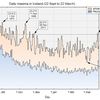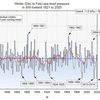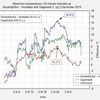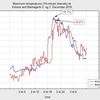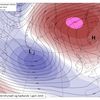Bloggfćrslur mánađarins, janúar 2012
30.1.2012 | 21:55
Calculating temperature averages in Iceland - part 1
This post outlines the problems of using daily maximum and minimum temperatures for the construction of long-term temperature series in Iceland. It is not a judgment on the use of the method elsewhere.
So-called fixed hour means (FHM) have been used for the calculation of mean monthly temperatures in Iceland since the Danish Meteorological Institute (DMI) took over weather observations in Iceland in 1872.
The fixed hour mean is the monthly average temperature at each of the observing times in the regular schedule at the respective station. Informally this average is also sometimes referred to as the clock mean.
In many parts of the world, the average of daily maximum and minimum temperatures (XNM) has been used for the calculation of the monthly mean temperature. In practice, there is a systematic difference between the two methods, but largely depending on location, time of the year, screen type etc. We will later look at the difference in Iceland.
There are a number of reasons for the preference of FHM rather than XNM in Iceland. We will look at a few of them:
1. The maximum and minimum thermometers are more difficult to read than other standard thermometers, as the gradation is often 0.5°C on the max and min thermometers, but 0.2°C on the others.
2. The max and min thermometers are touched and moved once or twice per day. The maximum thermometer is taken out of the screen and has to be reset by "force" (arm swing). In this process, it suffers more accidents than the fixed ones. Because of this the maximum and minimum temperature are often missing in older measurements, it took time to replace broken instruments. For this practical reason, maximum thermometers were in use at only few stations in earlier times. The minimum thermometers showed much more drift than other did, index corrections even up to 2 to 5°C were used.
3. The maximum and minimum reading practice has changed throughout time. This problem does not apply where there have been no such changes. There are at least two kinds of complications associated with changes in the reading practice.
(i)) The more serious one affected the Iceland temperature series from the 1932 to the 1950s, as the synoptic stations became more important in the network. The so-called Copenhagen observation practice (International Synoptic code of 1929) recommended that minimum temperatures were only read in the morning and the maximum only in the evening. It was also stipulated that both in the morning and the evening both thermometers should be reset and only the reset temperatures noted (for calibration purposes).
This has the consequence that if the actual highest temperature during the 24 hours really occurred during the night or the minimum during the day these were lost. In a later letter amending the codebook the observer was given free hand to note abnormal temperatures during this blank periods in the journal – but this was rarely done if at all. During a large part of the winter, the adiurnal variability (the vagaries of the weather systems) is very large in Iceland. During this time of the year many maxima and minima where thus lost. The diurnal variation is much more regular during summer and much fewer maxima or minima are lost. In lower latitudes, this problem is not as serious.
An analysis of this problem is to be found in the Hovmöller reference below. There one can read about the surprisingly large corrections that are necessary during the Copenhagen code period in Iceland.
(ii)) But why did the “Copenhagen code” introduce this problem? It was a remedy against the other reading practice effect, the problem of "double maxima" and minima. The "double maxima" are not uncommon in Iceland due to the abovementioned adiurnal variability of temperature. In the code that in 1949 replaced the Copenhagen code the maxima and minima where supposed to be read two (or four) times per day, if two times per day, then at 6 and 18 GMT. However, at six in the morning the observers must be paid at night work wages. Therefore, a compromise was made for Iceland, the maximum and minimum were there read at 9 and 18 GMT.
The 9 GMT reading has the advantage that it “caught” the real overnight minimum – in fair weather in spring and autumn it usually occurs very late in the night, after 6 GMT. By reading at 9 GMT the number of so-called double minima was largely avoided. When the minimum is read (and reset) only once per day, cold nights (night 1) smear over to a succeeding warmer night (night 2) – because the temperature at the reading time on night 1 is lower than the minimum of night 2. The Copenhagen reading practice avoided this by resetting the minimum thermometer at 18 GMT.
According to the Copenhagen practice, the maximum temperature was read and reset at 18 GMT, and a reset of the maximum thermometer at 9 GMT. In Iceland 18 GMT (17 local Icelandic time) is a bit early in the afternoon. Reading and reset time at 21 GMT should therefore be preferred. However, matter of costs also intervened. Most of the telephone (telegraph) stations in the countryside had closed by 21 GMT; they would be open only at a special cost. The 18 GMT reading was thus used at all of the synoptic stations.
When the climatic stations started to read the maximum and minimum thermometer twice per day, the reading was done at 22 GMT, which was then the traditional evening observation hour. This was changed to 21 GMT in 1961.
The practice of reading the maximum at both 9 and 18 GMT instead of 9 and 21 increased the number of “double maxima” in Iceland, i.e. when the temperature at 18 GMT on day 1 exceeds the highest maximum on the following day (day 2). The temperature at 18 on day 1 thus becomes the maximum temperature on day 2.
This also means that the average daily maximum temperature at the synoptic stations is tends to be slightly higher than the average maximum at similarly situated climatic stations.
This difficult history of maximum and minimum temperature measurements in Iceland should make it apparent why the FHM is preferred to the XNM in the construction of homogenous long-term temperature series in Iceland. However, the application of the FHM is not without problems – not at all. We will continue in the next post.
The Hovmöller (1960) report is available (in English). It is an essential read for historical climatologists, not only in Iceland, but also elsewhere.
Bloggar | Breytt 4.2.2012 kl. 02:04 | Slóđ | Facebook | Athugasemdir (0)
The first temperature observations were made at Bessastađir near Reykjavík í 1749. The eighteenth century observations are fragmentary and difficult to reconcile with modern observations. It is, however being attempted. Most of the still surviving observations before 1860 were made with instruments supplied by the Danish Scientific Society and the society supported some observations until 1880. A large observational project was initiated by The Icelandic Society of Letters in 1840. An overview of the early activity is given in Jonsson and Gardarsson (2001) and a more detailed report on the 1840 effort in Jonsson and Gardarsson (2008).
Most of the early observations series only include temperature, but in a few cases there were also observations of pressure and precipitation. An attempt has been made to construct a series of annual temperatures back to 1798 and monthly values as well for most of the years. An overview is given in the supplementary material of Wood et al. (2010). A daily pressure series has been constructed back to 1822. Jones et al. (1998) summarize this effort.
The Danish Meteorological Institute (DMI) was established in 1872. It became responsible for observations in the „auxiliary countries“ (Bilandene - The Faeroes, Iceland, Greenland and the Virgin Islands). The DMI immediately established a few stations and the number of their stations grew during the next decade. After that the number of stations remained quite stable until the First World War, but only a few of the stations observed during the whole period.
The stations where divided into two main types, the so-called main stations (Hovedstationer) and climate stations (Klimastationer). The main stations were equipped with thermometers, a barometer, hygrometer, precipitation gauge and snow frame. Three temperature, pressure, wind and weather observations were made per day, the maximum and minimum temperatures were read once per day as well and the precipitation total once per day. The observations at the DMI climatic stations were more primitive. Temperature observations where made three times per day. In a few cases the climate stations were equipped with minimum thermometers.
During the DMI period wall screens were the norm and all the official stations had temperature screens. Before 1870 the use of temperature screens was an exception. In the autumn of 1906 a cable connected with the international weather service system. A few observing stations were established at telegraph stations and the observations were distributed abroad as well as inland.
These new stations made observations three or four times per day, at fixed hours but not the same as at the traditional stations. The thermometer screens were simpler and most of the barometers were of the aneroid type whereas most of the earlier stations used mercury barometers. The new telegraph meteorological stations were decisively of a lower quality than the old main stations. The DMI did not calculate means for these stations. After the Icelandic Meteorological Office took over in 1920 most of the telegraph stations remained in a lower quality state for some time.
During the First World War the contact between the DMI and the Icelandic observers seems to have deteriorated and the station turnover was not maintained. The number of climate stations dropped and more journals are missing from this period than any other after 1873. However, in other respects the transition between the operation of the DMI and IMO was relatively smooth.
The IMO gradually reinforced the network and the number of stations grew throughout the next decades (see figure below). Maximum and minimum temperature thermometers were introduced at the stations during the 1930s as well as precipitation gauges. Records of visual observations also improved. After a new international synoptic observation code was introduced in 1929 the observation emphasis shifted gradually over to the telegraphic (now synoptic) stations. The last old-style climatic stations were phased out on 1 January 2012. The number of manned synoptic stations has also been drastically reduced during the last 10 years as more automatic stations have been established.
The figure shows the approximate number of manned stations measuring temperature in Iceland during 1869 to 2010. A few early stations are excluded (hopefully added later). The drop in number during the last 15 years has been more than compensated by automatic observations.
Some references:
Jones, P.D., T. Jónsson, and D. Wheeler, (1997) Extension to the North Atlantic Oscillation using early instrumental pressure observations from Gibraltar and South-West Iceland, International J. of Climatology Vol.17, 1433-1450.
Jónsson, T. and Hilmar Garđarsson (2001) Early Instrumental Meteorological Observations in Iceland.Climatic Change, 48, p.169-187
Jónsson T. og Hilmar G. Garđarsson (2009). Jónas Hallgrímsson og veđurathuganir á Íslandi um og upp úr 1840. (A full English version included) Skýrsla VÍ 2009-19.
Wood, KR ,JE Overland, T Jónsson and BV Smoliak (2010), Air temperature variations on the Atlantic-Arctic boundary since 1802 GRL 37, L17708, doi:10.1029/2010GL044176, 2010
Bloggar | Breytt 6.2.2012 kl. 17:39 | Slóđ | Facebook | Athugasemdir (3)
27.1.2012 | 16:34
The Iceland weather blog
The Iceland weather blog is an occasional venue for information on the weather and climate of Iceland and is an offshot of my active blog in Icelandic, hungurdiskar. A blog on the recent controversy on the adjustment of Icelandic temperature series will be posted in a few days (2 to 6).
Bloggar | Slóđ | Facebook | Athugasemdir (0)
Um bloggiđ
Iceland Weather blog
Nýjustu fćrslur
- Unusually high temperatures
- Unusually high sea level pressure
- Sea level pressure: Unusually low in Iceland this winter
- A new national maximum temperature record for December
- A new sea level pressure record for June in Iceland
- An unusually warm April in Iceland
- A new October high pressure record in Iceland
- A new absolute September maximum temperature record in Iceland
Heimsóknir
Flettingar
- Í dag (2.7.): 0
- Sl. sólarhring: 1
- Sl. viku: 11
- Frá upphafi: 0
Annađ
- Innlit í dag: 0
- Innlit sl. viku: 11
- Gestir í dag: 0
- IP-tölur í dag: 0
Uppfćrt á 3 mín. fresti.
Skýringar



 hoskibui
hoskibui
 svatli
svatli
